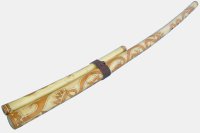
World Flutes Master

Take care of our enviroment

comprar

Peace web theme set courtesy of Crystal Cloud Graphics web set icon
Crystal Cloud Graphics
Crystal Cloud Graphics

Fujara
The fujara is a large folk shepherd's fipple flute of unique design, originating from Slovakia. It is typically 150-170 cm long, tuned in G (A and F are also available). It has three tone holes located on the lower part of the main body. Even though on almost all fujaras the fundamental frequency can be played,[1] the normal playing technique is based on overblowing the instrument, and because of its size the overtones create the possibility to play a diatonic scale using only three tone holes. The sound is produced by a fipple on the upper end of the main body of the fujara. The air is led to the fipple by a smaller parallel pipe, called a "vzduchovod," mounted on the main body of the instrument. This smaller parallel pipe enables that the player to reach the three tone holes. The fujara is played standing, with the instrument held vertically, braced usually against the right thigh.
The atypical design provides for a deep, meditative timbre. Ornaments are traditionally added to the base melodies, which usually occur in the mixolydian mode, including characteristic rapid tone scatter sequences, called "prefuk" (a rapid overblow of one note) or "rozfuk" (a descending cascade of overtones at the beginning of a fujara song).
Traditionally, the fujara was played for recreation, usually by shepherds. Today, though, the fujara has moved from the fields to the stage at folklore festivals in Východná and Detva, both in Slovakia.
The fujara is a large folk shepherd's fipple flute of unique design, originating from Slovakia. It is typically 150-170 cm long, tuned in G (A and F are also available). It has three tone holes located on the lower part of the main body. Even though on almost all fujaras the fundamental frequency can be played,[1] the normal playing technique is based on overblowing the instrument, and because of its size the overtones create the possibility to play a diatonic scale using only three tone holes. The sound is produced by a fipple on the upper end of the main body of the fujara. The air is led to the fipple by a smaller parallel pipe, called a "vzduchovod," mounted on the main body of the instrument. This smaller parallel pipe enables that the player to reach the three tone holes. The fujara is played standing, with the instrument held vertically, braced usually against the right thigh.
The atypical design provides for a deep, meditative timbre. Ornaments are traditionally added to the base melodies, which usually occur in the mixolydian mode, including characteristic rapid tone scatter sequences, called "prefuk" (a rapid overblow of one note) or "rozfuk" (a descending cascade of overtones at the beginning of a fujara song).
Traditionally, the fujara was played for recreation, usually by shepherds. Today, though, the fujara has moved from the fields to the stage at folklore festivals in Východná and Detva, both in Slovakia.










